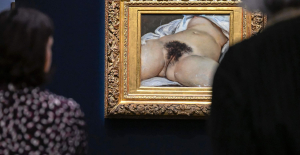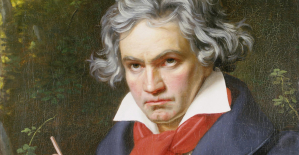Three yellow armchairs. A small round table and on it, a Pléiade. But not just any, the Pléiade des Pléiades. This Thursday, April 25, there was a large gathering to attend the presentation of the 671st volume of the prestigious Gallimard collection in the auditorium of the international city of Villers-Cotterêts. A perfect place to speak of poetry and a living language, as presented by Paul Rondin, the director of the castle which opened its doors in October last year.
“This international city is neither a museum nor a language conservatory. However, with the Pléiade, we are at the very place of poetry, of a language that invents. » Alongside Paul Rondin, Antoine Gallimard himself recalled this link which unites the castle, where the Ordinance of Villers-Cotterêts was signed in 1539 “prescribing that judgments, rulings or judicial acts would henceforth be in French” and poetry of the 16th century. Let us recall here, from 1547 to 1559, the Pléiade designates the first group of poets in the French language, made up of Ronsard, Du Bellay, Tyard, Baïf, Des Autels, Jodelle and La Péruse. At least, that's how it's presented. Because this name of movement was given retrospectively and it was not limited to these seven authors. But we'll come back to that.
“This order, which was a political gesture for the unity of the language as well as an administrative and cultural gesture, did not escape the poets during the reign of Henry II,” continued Antoine Gallimard. At that time, poets indeed had a political role. “They therefore understood the usefulness of illustrating the French language, by enriching it with Antiquity, from neighboring Italy, in order to allow a strengthening of the State and therefore, of the king. » Yes, but that was without taking into account that Henry II was “not very sensitive to poetry. Henri II owned hunting lodges, he loved Villers-Cotterêts for the quality of the deer meat. He was more sporting than literary. »
Also, this volume of La Pléiade constitutes an unpublished chronicle of the poets of La Pléiade under the reign of Henri II, as Mireille Huchon wrote in the introduction to the said work which she edited. In 1547, the first poems of Ronsard and Du Bellay appeared in the edition of the Poetic Works of Peletier du Mans. Very quickly followed by La Deffence, and illustrations of the French language, by Du Bellay, which passed for the "manifesto" of La Pléiade, L'Olive, which constituted the first collection of sonnets and original lyric verses in French as well as the Odes, in French by Ronsard.
“It’s a series of first moments,” explains Mireille Huchon. We are witnessing the first grammar of French, dictionaries appear and we see how much the language has enriched. » Between 1549 and 1552, collections of love poetry were born from the pen of Pontus de Tyard and Guillaume Des Autels, his cousin, while Les Amours de Baïf followed. “We witness the birth of Fouquelin's rhetoric in 1555, which founded French rhetoric and elocution, the first ancient tragedy, La Cleopatra captive, by Etienne Jodelle, the scandal of the Folastries and the first collections of French sonnets. » Poets experiment with genres, language, stanzas and verses, doing “neolatin”, like Du Bellay who composes in Latin and translates into French.
Is it fascinating that in this bustling period a group like that of La Pléiade was created. But, immediately tempers Hugues Pradier, medievalist historian and director of La Pléiade, the movement was retrospective. “Certainly, Ronsard used the term Pléiade once, but it was witnesses in the second part of the century who popularized the name. » In addition to this late designation, the Pléiade evolved and was not limited to the seven poets. “There were entries and exits. » When Ronsard used it in 1555, La Péruse was already dead. As for Des Altels, it was deleted for “political reasons.” Peletier gives way to Dorat, then re-enters the list, Belleau joins her. Surprisingly, we do not know if all these poets knew each other and if they ever saw each other. Ronsard and Du Bellay, “probably” met in 1547, but for the rest?
In any case, the Pléiade did not survive the end of the reign of Henry II and the death of Du Bellay in 1560. The fact remains that this decade greatly marked the century and those that followed. Also, this volume of La Pléiade is interesting, because, constructed in three parts, first an anthology of extracts of texts taken from fifty-one collections, then a poetic section bringing together the first French poetic arts, it also shows the controversies and testimonies that these “foolish” people from Pléiade aroused with their “poetic fury”.
The texts are given in their original form, we warn in a note at the beginning of the book. We then see the great upheavals in the Seizemist language, while a little less than a century before the birth of the French Academy, French and its spelling were free and wild. “This is a key moment in the history of the language and its codification,” exclaims Mireille Huchon. Poets played a major role. » The “i” also served as “j” in the 16th century (here the vowel and the consonant were distinguished). “The vowel u and the consonant v were used interchangeably, with often v at the initial of the word and u inside (pouuoir, vsage). » Here again, for the sake of readability, the u and the v have been distinguished.
Already in the 16th century, debates were heated around language and the status of spelling. The spellings differ. Opposed are those in favor of eliminating superfluous letters, with no effect on pronunciation and therefore in favor of phonetic spelling, and those in favor of customary spelling. “It is in relation to the Lyon grammarian Louis Meigret, a pioneer in the field of spelling reform, that Peletier positions themselves on the one hand, in a courteous controversy on the modalities of the reform and, on the other hand, Du Bellay , Ronsard and Des Autels.”
Du Bellay prefers to rely on “common, and antiq’ usage”. His works, writes Mireille Huchon, “are an excellent example of a fairly common spelling, left to the care of the printer: numerous y for i (celuy, traduyre), z in the end for plurals (petiz virtues)”. Ronsard, for his part, goes further than his friend and rival. In his Odes of 1550 eliminates the final “From Bellai”. However, he alternates between a common writing in Amours, (1552) and a modified writing like that of his Odes, in another edition of Amours a year later, but always choosing ultimately to avoid "all superfluous spelling".
Nearly a quarter of a millennium later, the French language still gives rise to just as many disputes. We saw this with the spelling corrections of 1990, which popular usage rarely applied, the feminization of professional names, should we write “author”, “auteure”, “autrice” and more recently with the writing inclusive, which some feverish activists are trying to impose, but which has so far barely crossed the border of political leaflets and advertising messages.

 Israel-Hamas war: Gaza between hope of truce and fear of Israeli offensive in the South
Israel-Hamas war: Gaza between hope of truce and fear of Israeli offensive in the South “Mom, Dad, please don’t die”: in the United States, a nine-year-old child saves the lives of his parents injured in a tornado
“Mom, Dad, please don’t die”: in the United States, a nine-year-old child saves the lives of his parents injured in a tornado War in Ukraine: Putin orders nuclear exercises in response to Macron and “Western leaders”
War in Ukraine: Putin orders nuclear exercises in response to Macron and “Western leaders” Mexico: the last moments of surfers found in a well, killed with a bullet to the head
Mexico: the last moments of surfers found in a well, killed with a bullet to the head A baby whose mother smoked during pregnancy will age more quickly
A baby whose mother smoked during pregnancy will age more quickly The euro zone economy grows in April at its best pace in almost a year but inflationary pressure increases
The euro zone economy grows in April at its best pace in almost a year but inflationary pressure increases Children born thanks to PMA do not have more cancers than others
Children born thanks to PMA do not have more cancers than others Breast cancer: less than one in two French women follow screening recommendations
Breast cancer: less than one in two French women follow screening recommendations “A potential environmental disaster”: Paris town hall opposes an oil drilling project in Seine-et-Marne
“A potential environmental disaster”: Paris town hall opposes an oil drilling project in Seine-et-Marne The governor of the Banque de France pleads for the development of French and European AI
The governor of the Banque de France pleads for the development of French and European AI Clariane (ex-Korian) announces a sale of its home hospitalization activities
Clariane (ex-Korian) announces a sale of its home hospitalization activities To everyone's surprise, the Hades 2 event video game is released in early access
To everyone's surprise, the Hades 2 event video game is released in early access The Origin of the World, exhibited at the Center Pompidou Metz, target of an “artistic performance”
The Origin of the World, exhibited at the Center Pompidou Metz, target of an “artistic performance” Threatened with death for having insulted the mobilized pro-Palestinian students, Élie Semoun files a complaint
Threatened with death for having insulted the mobilized pro-Palestinian students, Élie Semoun files a complaint Vienna, Paris, Milan celebrate the 200th anniversary of Beethoven's 9th Symphony
Vienna, Paris, Milan celebrate the 200th anniversary of Beethoven's 9th Symphony Cannes Film Festival: call for strike one week before opening
Cannes Film Festival: call for strike one week before opening Omoda 7, another Chinese car that could be manufactured in Spain
Omoda 7, another Chinese car that could be manufactured in Spain BYD chooses CA Auto Bank as financial partner in Spain
BYD chooses CA Auto Bank as financial partner in Spain Tesla and Baidu sign key agreement to boost development of autonomous driving
Tesla and Baidu sign key agreement to boost development of autonomous driving Skoda Kodiaq 2024: a 'beast' plug-in hybrid SUV
Skoda Kodiaq 2024: a 'beast' plug-in hybrid SUV The home mortgage firm rises 3.8% in February and the average interest moderates to 3.33%
The home mortgage firm rises 3.8% in February and the average interest moderates to 3.33% This is how housing prices have changed in Spain in the last decade
This is how housing prices have changed in Spain in the last decade The home mortgage firm drops 10% in January and interest soars to 3.46%
The home mortgage firm drops 10% in January and interest soars to 3.46% The jewel of the Rocío de Nagüeles urbanization: a dream villa in Marbella
The jewel of the Rocío de Nagüeles urbanization: a dream villa in Marbella Europeans: David Lisnard expresses his “essential and vital” support for François-Xavier Bellamy
Europeans: David Lisnard expresses his “essential and vital” support for François-Xavier Bellamy Facing Jordan Bardella, the popularity match turns to Gabriel Attal’s advantage
Facing Jordan Bardella, the popularity match turns to Gabriel Attal’s advantage Europeans: a senior official on the National Rally list
Europeans: a senior official on the National Rally list Blockade of Sciences Po: the right denounces a “drift”, the government charges the rebels
Blockade of Sciences Po: the right denounces a “drift”, the government charges the rebels These French cities that will boycott the World Cup in Qatar
These French cities that will boycott the World Cup in Qatar Foot: Italian football protests against a government project which aims to monitor club finances
Foot: Italian football protests against a government project which aims to monitor club finances Champions League: “We are ready for anything,” warns Edin Terzic before PSG-Dortmund
Champions League: “We are ready for anything,” warns Edin Terzic before PSG-Dortmund Premier League: David Moyes to leave West Ham at end of season
Premier League: David Moyes to leave West Ham at end of season Transat CIC: Yoann Richomme winner in the wake of Tabarly, Poupon, Peyron, Desjoyeaux...
Transat CIC: Yoann Richomme winner in the wake of Tabarly, Poupon, Peyron, Desjoyeaux...


















